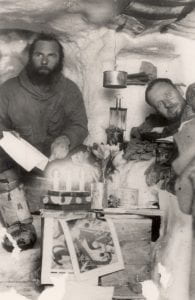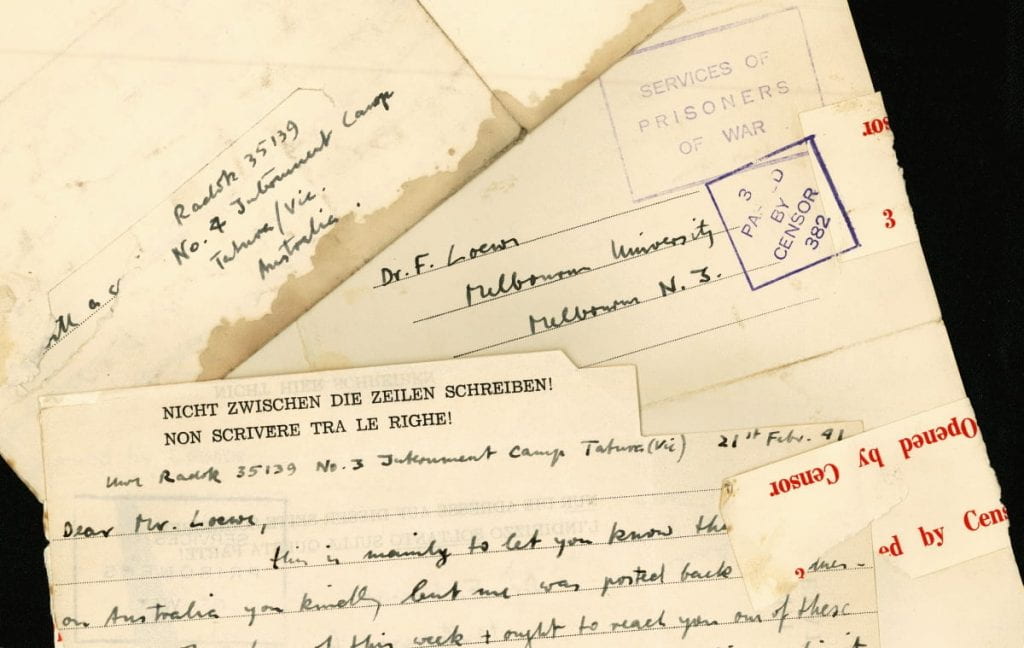
Archive of a Refugee Scientist
Today 9 June is International Archives Day, and in September the International Council on Archives is holding its Congress in Seoul on the topic of Archives, Harmony and Friendship. In the digital age when collections and institutions are more connected we are used to thinking internationally about archives. The wanderings of pre-digital archives often reveal remarkable stories. One archival trail in our holdings at the University of Melbourne Archives that goes all the way from the North Pole to the South Pole is left by meteorologist Fritz Loewe. As a Jewish refugee he was also caught up in one of the great exoduses of the twentieth century.

Loewe had served as assistant glaciologist to the expedition leader of the German Greenland Expedition (1930-31), Alfred Wegener, who first developed the theory of continental drift. Between October 1930 and the following May, Loewe lived in an ice cave with expedition member Ernest Sorge and one other scientist, when Loewe’s toes were amputated for frost bite. While this saved him from perishing on the return journey to the base like Wegener, ice bound camaraderie with Sorge did not survive the Nazi era.
Loewe, working for the Prussian Meteorological Service, was among some 2000 German academics and researchers who lost their jobs after the Nazi civil service reforms of 1933, which prohibited Jewish employees. If this wasn’t bad enough, Loewe was reported to the police by his erstwhile colleague and Nazi Party member, Sorge, for complaining about the treatment of Loewe’s brother-in-law by the Sturmabteilung (the paramilitary wing of the Nazi Party). Wegener’s brother Kurt, who took over as leader for the Greenland expedition in 1930, provided a reference to get Loewe out of jail.
Loewe migrated to England with his family in 1934, where he worked as an Advanced Research Student in the Scott Polar Research Institute at the University of Cambridge. The University of Melbourne Vice-Chancellor, geologist and polar scientist Raymond Priestley, met the refugee scientist on a visit in the English summer of 1936.
Priestley was keen to secure Loewe’s services, not least because the German Air Ministry was rumoured to want him back. The Australians wanted him too. Priestley earmarked one of two ‘refugee’ Carnegie Fellowships awarded to the University of Melbourne.
Loewe arrived in Melbourne in 1937 and taught the first intake of Royal Australian Air Force navigators, and when he was appointed the University of Melbourne’s first lecturer of meteorology in 1939 trained scientists for the Australian Bureau of Meteorology. A gesture of international friendship at the same time served national self-interest, providing a way to boost scientific expertise and fill a technical skills gap.
Loewe joined several Antarctic expeditions including as an observer to the French Commandant Charcot expedition 1950-51, where he produced a detailed mass balance of the Antarctic ice sheet. Australia’s territorial claims in East Antarctica bordered the French claim and Loewe was fluent in French having studied law in Grenoble before World War One.

Historians are increasingly wary of simply celebrating the impact of European Jewish refugees on the English speaking academy, as evidenced by multiple Nobel Prize winners, new disciplines and leading research schools, not to mention the atomic bomb. England acted as a clearing house for academic refugees on the way to another country, mostly the United States of America. In 1940, 30,000 European refugees were interned in England as enemy aliens and thousands deported including the earth scientist Uwe Radok. On arrival in Australia, he was interned again at a camp at near Tatura in Victoria. Loewe and Radok co-discovered the sub-tropical jet stream in 1950.
Behind stories of survival, resilience and success is a more complicated one of the fragmentation and deflection, if not the ruin, of many careers and lives. Scientists like Loewe tended to do better in new or ‘marginal’ disciplines and many Jewish refugees changed their disciplines or direction as a result of emigration. Many could not continue their paid work at all; rarely under the same conditions and status as previously.
Not only did Loewe develop his scientific career, he was also able to steward his archive: through Germany, Greenland, England, Australia and Antarctica, and finally, to preserve it in Melbourne. It gestures to stories that are yet to be – or may never be – discovered in the Archives.
Katrina Dean (2015) Situating Fritz Loewe: Scientist, Émigré, The Australia Jewish Historical Society Journal, 22/3, pp.497-511.
A selection of photographs from the Loewe collection is accessible online through the University of Melbourne Archives digitised items catalogue: http://archives.unimelb.edu.au (type 1988.0160 into the digitised items search box).
Or see the University of Melbourne Archives Facebook photo album https://www.facebook.com/University-of-Melbourne-Archives-225329370847089/photos/?tab=album&album_id=753337708046250
AUTHOR PLEASE
I was most interested to read about Fritz Loewe, which told me a lot about a polar person I’d never heard of before.
Apologies if I have in fact overlooked this information — I’d like to know who wrote the beautifully written piece on the website.
Hi Bernadette – thanks for the comment. This piece was written by University Archivist Dr. Katrina Dean. We have also just put some photographs from Loewe’s many polar adventures on our website. Use the search term ‘Loewe’ in the Digitised Items Catalogue on our home page http://archives.unimelb.edu.au/